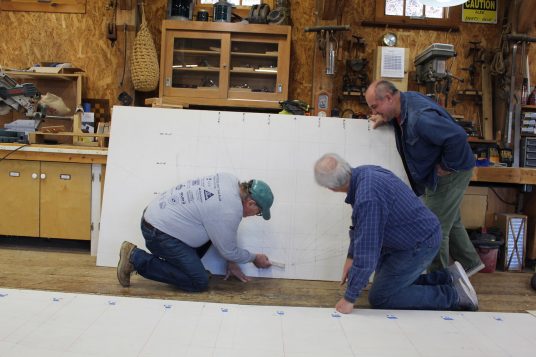Despite the chiseled blocks of ice stationed around the village, downtown Port Jefferson was red hot last weekend during the 4th annual Port Jefferson Ice Festival, hosted by the village’s Business Improvement District.
This two-day celebration took place on Jan. 28 and 29, bringing together several local institutions, dozens of small businesses and a whole lot of ice. Roger Rutherford, Port Jefferson BID president and general manager of Roger’s Frigate, summarized the boost the festival brought to storefronts.
“This is the slowest time of the year for the business community,” he said. “This is our fourth annual, and it has really taken off and turned into something spectacular.”
Making the festivities possible required significant organizational collaboration between the BID and its partners. The Greater Port Jefferson Chamber of Commerce assisted by facilitating a mac ’n’ cheese crawl.
With 12 participating restaurants, the crawl offered festivalgoers a chance to taste various cuisines from food establishments around the village.
“This is the second year they asked us to be the administrators for the mac ’n’ cheese crawl,” said chamber executive director Barbara Ransome. “They go to 12 places. It’s four ounces of mac ’n’ cheese [per stop], so you’re talking three pounds [in all].” She added, “It’s a lot of mac ’n’ cheese.”
Thousands flocked to the village to partake in the fun, including trustee Stan Loucks who projected the weekend as one of the highest local turnouts on record.
“I have never seen so many people in our village,” he said. “The merchants were extremely happy with the crowd. They did very well this weekend, and I think it was terrific to see that many people walking around our village.”
James Luciano, owner of PJ Lobster House, reacted to the festival’s success in stimulating small businesses.
“This festival brings in a lot of business for us,” he said. “This time of year, you’re lucky to get a couple of tables for lunch and a couple of bar customers.” But, he added, “We’ve been full since we opened the door.”
Meltdown
The sizable show gave much-needed relief to storefront owners still recovering from the aftereffects of the COVID-19 pandemic. Almost three years ago, the world and nation were shocked by the outbreak of the pandemic, leaving downtowns such as Port Jeff’s in disarray.‘The businesses were thriving, the restaurants were full.’
— Kathianne Snaden
Indu Kaur is the owner of the Curry Club at SāGhar in Port Jefferson, an establishment that opened in February 2020, just weeks before the lockdowns.
“We took over the business and had no idea that we were going to be shut down,” Kaur said, describing the impact of the pandemic on her business as “a huge tragedy.”
In the face of hardship, Kaur and her staff continued operations by donating meals, then reopened in the fall of that year. With a historic turnout villagewide, Kaur regarded the resurgence of the downtown businesses with delight.
“It’s so exciting to see everyone walking around, enjoying our village, enjoying the new restaurants, the new shows and our ice sculptures,” she said.
Outside Kaur’s restaurant lay a decorative ice sculpture depicting Ganesha, a Hindu deity tying into the theme of local renaissance. “Lord Ganesha is the statue that we all have faith brings prosperity, happiness and peace,” she said.
Icebreaker
Ganesha was just one of a few dozen ice sculptures displayed throughout the village. Many visitors stood and posed with the ice, which was often interactive. Some sculptures depicted animals, others tied in with the businesses for which they were custom made.
Rich Daly, president and owner of Ice Memories, has created sculptures during each of the festival’s four iterations. He discussed the considerable effort and material that made it all possible.
“We do live carvings and have about 90,000 pounds worth of ice set up throughout town,” supplied by Riverhead-based Long Island Ice, Daly said. “Every year, we add more ice and more activities for everybody to do.”
Daly got interested in ice sculpting during culinary school, where he first received an ice carving assignment. “Once they put a chainsaw in my hands, I just never let it go,” he said.
Given how a sculpture shapeshifts and reforms during the different melting stages, the temporality and mutability of the ice medium offer both challenge and opportunity for creative expression.
“It’s a temporary art form, which makes it unique,” Daly said. “Especially on a day like today or a weekend like this, Mother Nature just doesn’t want the ice to be around,” adding, “As it melts, it just kind of changes and transforms, and it’s pretty cool.”
Daly said the process is relatively straightforward for those interested in carving ice. Blocks of ice, he said, can be acquired at most ice plants on Long Island. “It doesn’t take a crazy amount of money to buy tools,” he said. “Just have at it. Start [carving] whatever inspires you.”
Tip of the iceberg
Spring-like temperatures and melting points played a prominent role throughout the festival, with some environmentalists ringing the alarm about the threat of climate change.
Posted along Main, a small group of protesters lined the sidewalks with signs that read: “There is no planet ‘B’” and “Be nice, save the ice.” Holly Fils-Aime, president of the local environmental group EcoLeague, discussed how the melting sculptures signal a dangerous trend.
“The fact that these sculptures didn’t last the day because it’s so warm out here in January is a great teaching device,” Fils-Aime said.
Picketing alongside Fils-Aime was village resident Myrna Gordon, who stressed the importance of local government in identifying environmental problems and implementing science-based solutions.
“In my own village here in Port Jefferson, I think that a lot more has to be done with environmental issues,” she said. “Having an ice festival is wonderful — bringing people to the village, helping the businesses. But we also need to focus on very, very serious issues that are happening here.”
Frozen in time
Through the ice fest, scores of people interacted with the various facets of the community. While there wasn’t an ice sculpture outside the Bayles Boat Shop, boat builders continued their work on the Resolution whaleboat project.
“We’re in the finalizing stages of lofting,” said John Janicek, treasurer of the boat shop. After that, the buildout of the keel and stem can commence.
As the whaleboat enters a pivotal moment in its buildout process, the village is undergoing a transition of its own, moving into the post-pandemic era. With downtown thriving once again, Deputy Mayor Kathianne Snaden gave her thoughts on these positive developments.
“It was incredible to see so many people enjoy the village this time of year,” she said. “The businesses were thriving, the restaurants were full. There were shoppers and diners, and it was great to see the comeback.”





































